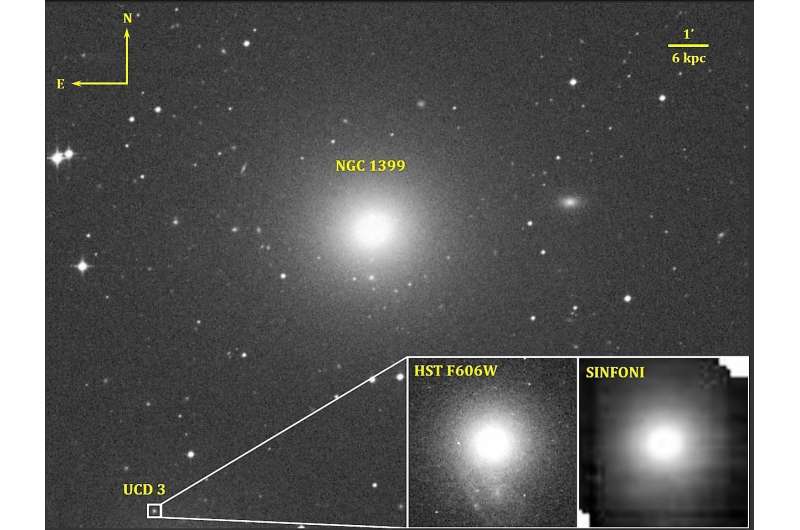Astronomers discover supermassive black hole in an ultracompact dwarf galaxy

A team of scientists from the Faculty of Physics and Sternberg State Astronomical Institute, MSU, leading an international collaboration with members from Europe, Chile, the U.S. and Australia discovered a supermassive black hole in the center of the Fornax galaxy. The results of the research were published in Monthly Notices of the Royal Astronomical Society journal.
Fornax UCD3 is a part of a Fornax galaxy cluster and belongs to a very rare and unusual class of galaxies, ultracompact dwarfs. The mass of such dwarf galaxies reaches several dozen millions of solar masses, and the radius does not typically exceed 300 light years. This ratio between mass and size makes UCDs the densest stellar systems in the universe.
"We have discovered a supermassive black hole in the center of Fornax UCD3. The black hole mass is 3.5 million that of the sun, similar to the central black hole in our own Milky Way," explained Anton Afanasiev, the first author of the article, a student of the department of the Faculty of Physics, MSU.
In the course of the study, the scientists used the data collected with SINFONI, an infrared integral field spectrograph installed at one of the 8.2 meter VLT telescopes in Chile operated by the European Southern Observatory. Having analyzed the observed spectra, the authors derived the dependence between stellar velocity dispersion and radius in Fornax UCD3. Velocity dispersion quantifies the average variation between the individual stellar line-of-sight velocity and the mean velocity of the entire stellar population. In the presence of a massive body such as a black hole, the stars are influenced by its gravity and accelerate in different directions. Due to that, their average speed does not grow, but the dispersion increases considerably. This is the very effect that was observed in this galaxy—the velocity dispersion in its center is so high that it can only be explained by the presence of a massive central black hole.
After that, the scientists compared the dependence of velocity and dispersion with dynamic models based on different assumptions of black hole mass. They found that the model suggesting the mass of the black hole being equal to 3.5 million solar masses agreed with the observations best. They also considered the possibility that no black hole was present there at all, but that hypothesis was excluded with the statistical significance of (99.7 percent).
The black hole discovered by the authors is the fourth ever to be found in UCDs and corresponds to 4 percent of the total galaxy mass. In average galaxies, this ratio is considerably lower (about 0.3 percent). Though there are few known examples, the existence of massive black holes in UCDs is a strong argument for the tidal origin of such galaxies. According to this hypothesis, an average-sized galaxy passed a bigger and more massive one at a certain stage of its evolution, and as a result of the influence of tidal forces, lost the majority of its stars. The remaining compact nucleus has become what we know as an ultracompact dwarf.
"To be able to say with complete assurance that this hypothesis is correct, we need to discover more supermassive black holes in UCDs. This is one of the prospects of this work.
Moreover, a similar methodology may be applied to more massive and less dense compact elliptical galaxies. In one of our next works, we will study the population of central black holes in objects of this kind," concluded the scientist.
More information: Anton V Afanasiev et al, A 3.5 million Solar masses black hole in the centre of the ultracompact dwarf galaxy fornax UCD3, Monthly Notices of the Royal Astronomical Society (2018). DOI: 10.1093/mnras/sty913
Journal information: Monthly Notices of the Royal Astronomical Society
Provided by Lomonosov Moscow State University





















